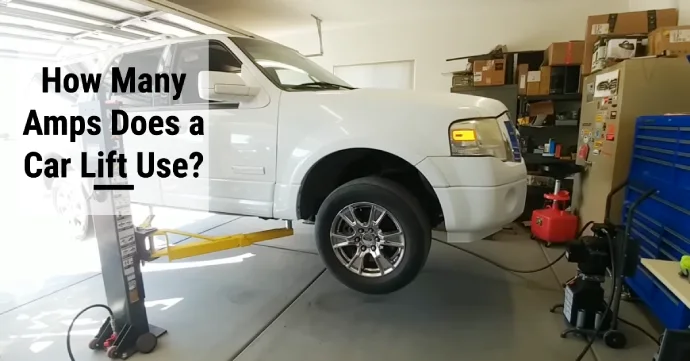Last Updated on June 19, 2023
Are you planning on installing a car lift in your garage? Before you do, knowing how many amps a car lift requires to operate safely and efficiently is important. Understanding the electrical needs of your car lift can help you avoid electrical hazards and costly repairs.
Most car lifts require a 220-volt power source and an amp rating between 15 and 50 amps. The exact amp requirement for your car lift will depend on its weight capacity, lifting height, and motor power. Also, you need the right amperage breaker and wiring for your lift’s safety and to avoid electrical fires.
Let’s discuss the typical amp requirements for car lifts, the size of breaker you need for a 2-post car lift, and the consequences of connecting the wrong amp power unit. So, let’s dive in and learn how many amps a car lift uses.
How Many Amps Does a Car Lift Use?
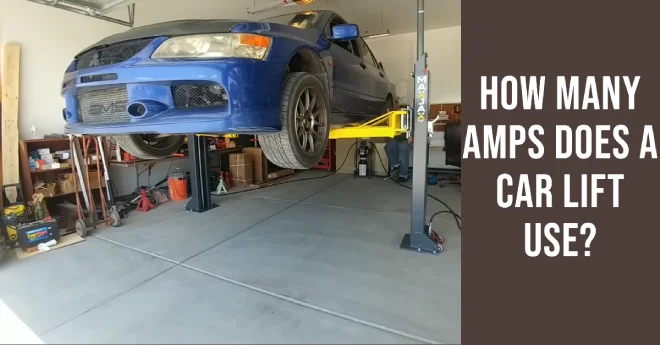
It depends on the lift type if you’re wondering how many electrical amps a car lift uses.
For 4-Post Car Lift:
A 4-post commercial grade auto lift with a 220 Volt single phase motor requires at least 30 amps of service and 10 gauge wire. This lift type is designed for heavy-duty usage in a professional garage setting. With this power supply level, the lift can lift bigger vehicles and provide more stability.
But if you have a 4-post hobbyist lift, you only need a 110 Volt grounded power supply with 30 amps service. This lift type is more suitable for personal use in a home garage or small workshop.
For 2-Post Car Lift:
A 220 Volt single phase car lift motor requires 14.5-16.5 amp service, so ensure your electrical system can handle this load. Upgrading from a standard 15 amp outlet to a 20 amp GFCI outlet can help prevent electrical hazards and ensure your lift operates safely.
An unreliable lift could pose a serious safety hazard, especially if you work alone in your garage with a vehicle suspended in the air.
What Is the Typical Amp Requirement for Most Car Lifts?
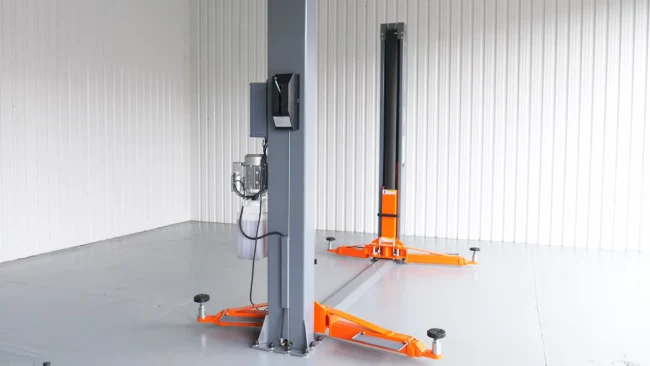
Most car lifts consume significant electricity, typically between 15 and 25 amps. This is because car lifts require a lot of torque to lift heavy vehicles safely. The motor must generate enough power to lift the car smoothly without sudden jerks or movements.
Ensure that your electrical system can handle the amp requirement of your car lift. If your electrical system is not capable of providing enough power, the lift may not work properly or could even cause damage.
What Size Breaker Do I Need for a 2-Post Lift?
The size of the breaker you need for your 2-post lift is a 30 amp breaker. This is the recommended size for most lifts, ensuring your lift has enough power to operate effectively.
To avoid accidents or damage to your electrical system, your lift’s amp requirements should be met by your electrical system.
What Happens if You Use the Wrong Amp Power Unit on a Car Lift?
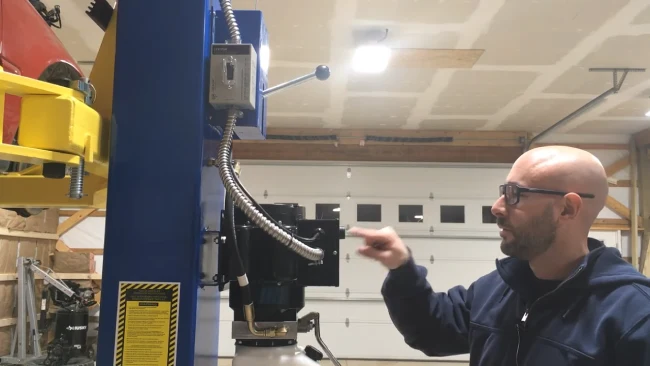
If you use the incorrect amp power unit for your car lift, you’re setting yourself up for many problems. Insufficient electrical power can cause the lift to operate slowly or not at all, while overloading can damage the lift’s components.
Here are some consequences:
Insufficient Power
When the amp power unit doesn’t meet the lift’s requirements, the lift operates slowly, struggles to reach the desired height, or doesn’t work. Insufficient power can cause the lift to strain, resulting in slow or sluggish movements. This can make it difficult to lift heavy cars or reach higher elevations.
Also, the lift may not function if the power unit is strong enough. This can be a safety hazard, as the lift may fail or collapse if it cannot support the car’s weight. So ensure the amp power unit meets the lift’s requirements to prevent any accidents or damage.
Overloading
Overloading the amp power unit of the car lift will not work and result in serious damage to the vehicle. It can strain the lift’s components, resulting in mechanical failure or collapse.
Because the power unit is not designed to handle the load capacity of the car lift, lifting a vehicle that exceeds its capacity may cause it to malfunction.
Motor Damage
Overworked lift motors are prone to overheating and early wear, resulting in costly repairs and downtime. When a lift is utilized beyond its capacity for extended periods, it exceeds its power draw, causing the motor to work harder than intended.
This strain can cause engine damage, overheating, and reduced longevity. If the damage is extensive, the motor may fail completely, requiring costly repairs or a complete replacement.
Not only is this type of damage expensive, but it also poses a significant safety risk. If the motor fails during operation, the lift may instantly plummet, resulting in severe injury or death.
Safety Hazards
Ensure you aren’t endangering yourself or others using a power unit incompatible with your car lift. If the power unit doesn’t provide enough amps, it can lead to safety hazards like unstable lifting, sudden drops, or unintended movements.
These risks may endanger the operator, the lifted vehicle, or anyone in the surrounding area. The lift’s safety mechanisms may also malfunction if the power unit is incompatible, increasing the risk of accidents.
Do car lifts require a dedicated circuit?
To ensure your car lift’s safe installation and operation, you must have a dedicated circuit with either a time delay fuse or a double pole circuit breaker rated at 25 amps. This means the circuit should only be used for the car lift and not shared with any other appliance or device in your garage.
Because car lifts need a lot of power to operate, sharing a circuit with other devices could cause the circuit to overload, creating a safety hazard. Here’s why you need a dedicated circuit for your car lift:
- Shared circuits can cause the circuit breaker to trip frequently, which can be frustrating and time-consuming.
- Sharing a circuit can also cause damage to the car lift and other appliances, as the power supply may not be stable or consistent.
- Sharing a circuit can sometimes violate electrical codes and regulations, resulting in fines or legal action.
Do I need a disconnect for a car lift?
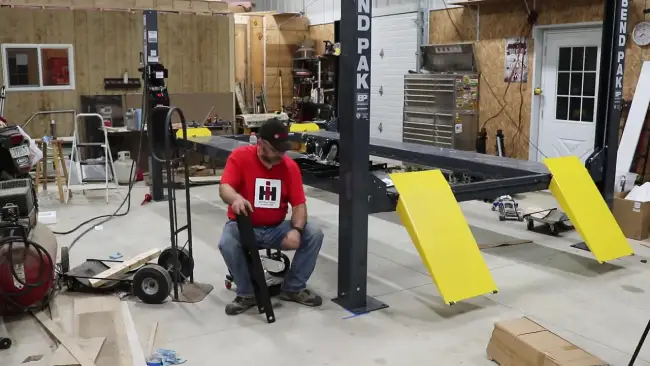
According to electrical code regulations, you will need a disconnect device if you consider installing an automotive lifting device. In an emergency, this device is essential for safety reasons, as it allows the power supply to the lift to be easily and quickly shut off.
Here are some important things to know about disconnect devices for car lifts:
- The respective electrical code requires every automotive lifting device to install a disconnect device.
- The disconnect device must be located within sight of the lift and accessible to the operator.
- Choosing a disconnect device that is rated appropriately for the amperage of the lift and the voltage of the power supply is important.
So, to ensure the safety of both the operator and the lift, have a disconnect device installed according to electrical code regulations.
Safely Power Your Car Lift: Determine Amp Requirements
Now know the standard amp requirement for most car lifts and what size breaker you need for a 2 post lift. Remember, choosing the wrong amplification power for a car lift can result in serious consequences, so ensure you have the correct setup.
Also, car lifts typically require a dedicated circuit and should not share the same circuit as other appliances. It’s recommended to have a disconnect for the car lift for safety purposes. So, ensure you have everything set up correctly to avoid accidents or mishaps.
